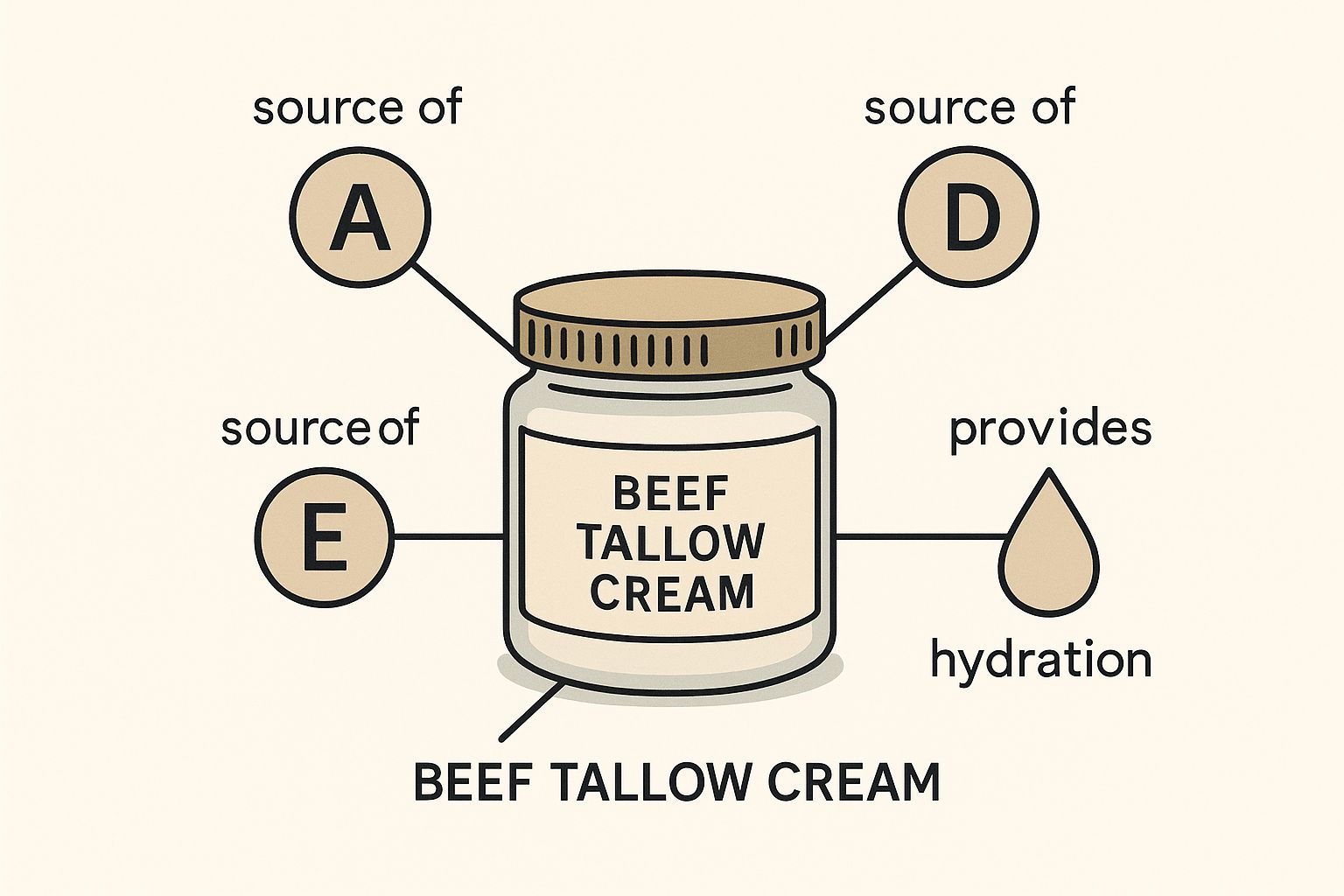In a world overflowing with complicated, 10-step skincare routines, it’s easy to feel overwhelmed. But there’s a quiet movement gaining momentum—a shift back to the basics, looking to the past for simpler, more powerful solutions our ancestors relied on for generations. This brings us to a rediscovered gem: beef tallow face cream.
It’s a return to an incredibly nutrient-dense ingredient that our skin just seems to get.
Rediscovering Ancestral Skincare Wisdom
For centuries, animal fats were the gold standard in skincare, valued for their unmatched ability to deeply nourish and protect the skin. That age-old wisdom is making a serious comeback, not just as a passing trend, but as a real alternative for anyone chasing authentic, no-nonsense skin health. It’s about consciously stepping away from synthetic chemicals and embracing ingredients that work with our bodies, not against them.
This isn’t just about nostalgia, either. The numbers back it up. The global market for beef tallow moisturizer has already hit an impressive USD 1.27 billion, with the North American market alone valued at over USD 470 million. Consumers are driving this surge; they're tired of squinting at long, confusing ingredient lists and are demanding transparency and purity in their products. You can dive deeper into this growing market over at marketintelo.com.
So, what's really behind this movement? It all comes down to a simple philosophy:
- Nutrient Density: Focusing on ingredients packed with the vitamins and fatty acids that genuinely feed the skin.
- Bio-Compatibility: Using substances that closely mimic our skin's natural oils, which means they absorb beautifully.
- Minimalism: The core belief that a handful of high-quality ingredients can deliver far better, more reliable results than a cocktail of synthetics.
This guide will walk you through exactly why beef tallow face cream is becoming a staple in modern clean beauty, offering a potent and surprisingly simple path to a healthy, resilient complexion.
Why Your Skin Recognizes Beef Tallow
So, what’s the big deal with putting beef tallow on your face? It might sound strange at first, but it comes down to one simple, powerful concept: your skin recognizes it. Think of it like a key that fits a lock perfectly.
At its most basic, tallow is rendered and purified beef fat. But the real magic is in its chemical makeup. The secret ingredient here is biocompatibility. The fat profile in high-quality tallow is remarkably similar to the natural oils—or sebum—that our own skin produces to keep itself hydrated and healthy.
Because of this uncanny resemblance, your skin doesn't treat it like a foreign invader. Instead of just sitting on top of the skin, which many synthetic or even plant-based moisturizers do, tallow is welcomed right in. It absorbs beautifully, getting down to the deeper layers where it can really start working to repair and fortify your skin's moisture barrier.
A Perfect Match for Your Skin
This natural harmony is what makes tallow feel so different and so effective. It’s delivering a payload of essential nutrients directly where they're needed, all without throwing your skin's delicate ecosystem out of whack. This is a world away from many synthetic ingredients that might offer a quick, temporary fix but do little to support your skin's long-term health.
Tallow works with your skin, not just on it. It reinforces the skin's natural functions, helping it become more resilient, balanced, and self-sufficient over time. This synergy is the foundation of its gentle yet powerful effect.
This visual breaks down the key vitamins and moisturizing elements that make beef tallow such a powerhouse for your skin.

As you can see, tallow is packed with fat-soluble vitamins like A, D, and E—all crucial for cell repair, regeneration, and protecting your skin from environmental stressors.
The Building Blocks of a Healthy Skin Barrier
Let's quickly compare tallow to more common plant-based oils to see why it has such an edge. While oils like coconut or jojoba have their own benefits, their fatty acid structure is fundamentally different from our skin's.
Beef Tallow vs Plant-Based Oils Key Differences
| Feature | Beef Tallow | Common Plant-Based Oils (e.g., Coconut, Jojoba) |
|---|---|---|
| Lipid Profile | Closely mimics human sebum with a balanced ratio of saturated to unsaturated fats. | Varies greatly; can be high in specific fatty acids (like lauric acid in coconut) that don't match our skin's natural composition. |
| Nutrient Synergy | Contains fat-soluble vitamins A, D, E, and K2 in their natural, bioavailable form. | Often contains Vitamin E, but typically lacks the full spectrum of A, D, and K2 found in tallow. |
| Absorption | Readily absorbed due to its similarity to our skin's oils, providing deep, lasting moisture. | Can sometimes sit on the skin's surface or, in some cases (like coconut oil), be comedogenic for certain skin types. |
| Saturated Fat Content | High in stable saturated fats (like stearic and palmitic acid) that are key components of the skin barrier. | Lower in the specific saturated fats that our skin barrier is built from, offering a different kind of moisturization. |
The fatty acids in tallow are especially important for reinforcing that skin barrier:
- Oleic Acid: A fantastic moisturizer that helps soften skin and improve its overall texture.
- Palmitic Acid: This one is a protector, helping to fortify the skin barrier and improve its smoothness.
- Stearic Acid: An essential building block that helps lock in moisture, keeping your skin supple and resilient.
Because these are the very components your skin uses to build itself, they are absorbed and put to work with incredible efficiency. This is why beef tallow face cream feels like such an intuitive, natural choice for bringing dry, stressed-out skin back to life.
What Tallow Actually Does For Your Skin

When you use a high-quality beef tallow face cream, you're not just putting on another moisturizer. You’re giving your skin a complete, bioavailable meal. This isn't about surface-level hydration; it’s about providing a trio of benefits that work together to bring back balance, resilience, and a genuine glow.
The first thing you’ll notice is deep, lasting hydration. Because tallow’s fatty acid profile is so close to our skin's natural oils (sebum), it sinks in beautifully instead of just sitting on top. This reinforces your skin's moisture barrier, kind of like patching a leaky roof. It locks in the good stuff and keeps environmental stressors like wind, cold, and pollution out. If you've been fighting a losing battle with dry skin, this can be a total game-changer.
A Powerhouse of Skin-Essential Vitamins
But tallow does more than just moisturize. It’s naturally loaded with fat-soluble vitamins that your skin craves—vitamins you often won't find in plant-based creams. They all work together to repair, protect, and revitalize your skin from the inside out.
- Vitamin A: Helps with skin cell turnover, which is key to keeping pores clear and your skin feeling smooth.
- Vitamin D: Plays a huge part in skin cell growth and repair, helping to build a strong, healthy barrier.
- Vitamin E: A potent antioxidant that defends your skin cells from the damage caused by free radicals and daily life.
- Vitamin K2: An often-overlooked nutrient that helps improve skin elasticity and can calm down redness and irritation.
This unique combination is what makes tallow so effective at feeding your skin on a cellular level. To really get into the weeds, you can learn more about the specific beef tallow benefits for skin in our detailed guide.
Soothing Relief for Sensitive Skin
Finally, tallow has natural anti-inflammatory properties. This makes it an incredibly gentle and effective choice for calming down angry, sensitive, or irritated skin. Issues like eczema, rosacea, and persistent redness often stem from a weak skin barrier and low-grade inflammation.
Tallow gets to the heart of the problem. It delivers the essential fatty acids needed to rebuild that protective barrier while its soothing nutrients help dial down inflammation and bring relief. It doesn't just cover up the symptoms; it addresses the cause.
This calming action, paired with its incredible moisturizing ability and nutrient profile, is exactly why so many people with reactive skin feel like they’ve finally found their simple, effective solution.
How to Choose a High-Quality Tallow Cream

As tallow cream becomes more popular, not every jar you find will be the same. To get the results you're looking for, you need to know how to spot the truly good stuff. Think of yourself as a detective, and the most important clue is always the source of the tallow.
The non-negotiable starting point is tallow from 100% grass-fed and grass-finished cattle. This isn't just a trendy label—it fundamentally changes the cream's nutritional makeup. Tallow from grass-fed cows is packed with more omega-3s and skin-loving vitamins like A, D, and E than tallow from their grain-fed counterparts. To go deeper on this, you can learn more about where does tallow come from and see why this difference is so crucial.
What to Look for on the Label
Once you've confirmed the source, the ingredient list and processing methods will tell you the rest of the story.
- Low-Heat Rendering: Harsh, high heat can destroy the very nutrients you're trying to get on your skin. The best brands use a slow, traditional, low-heat rendering process that keeps all those beneficial fatty acids and vitamins intact.
- Minimal Ingredients: A top-tier tallow cream doesn't need a laundry list of additives to work. The most effective formulas often contain just tallow, maybe a high-quality carrier oil like olive oil, and a bit of beeswax to get the texture just right.
- No Synthetic Additives: Be on the lookout for synthetic fragrances, harsh preservatives, and other chemicals. These can easily irritate sensitive skin, completely undermining the reason you chose a natural product in the first place.
Your goal is to find a beef tallow face cream that’s as close to its natural state as possible. The shorter the ingredient list, the more you can trust the purity and power of the tallow itself.
This push for pure, traditional ingredients is making waves. The tallow market, valued at USD 9.02 billion, is projected to hit USD 13.61 billion by 2030, largely because people are rediscovering the power of time-tested, effective skincare.
How to Work Beef Tallow Into Your Skincare Routine
Bringing beef tallow face cream into your daily ritual is easier than you might think. The golden rule? A little goes a long, long way. This isn't your typical drugstore lotion. Tallow is incredibly rich and nutrient-dense, so you only need a tiny amount to get the job done.
First, always start with a clean face. I recommend leaving your skin just slightly damp after washing, as this little bit of moisture helps the cream spread evenly and absorb deeply.
Next, scoop out a small, pea-sized amount. Warm it up between your fingertips for a few seconds until it softens and melts. You'll feel it transform into a silky, almost liquid gold that’s ready to apply.
Getting That Healthy Glow
Instead of rubbing, gently press the warmed tallow onto your face and neck. This pressing motion helps the cream penetrate the skin's layers, delivering all those incredible nutrients where they're needed most. It also prevents that heavy, greasy feeling some people worry about.
The secret to a dewy, nourished look—not a shiny one—is applying the tallow to damp skin. This simple trick locks in hydration and gives you a healthy sheen that works beautifully on its own or as a base for makeup.
You might be surprised to learn that beef tallow face cream makes an amazing primer. It creates a smooth, hydrated canvas that helps foundation glide on flawlessly, all while forming a protective barrier that keeps your skin moisturized throughout the day. It's gentle enough to use morning and night.
For the best results, what you wash your face with matters just as much. Pairing your cream with a gentle, non-stripping cleanser is key. To learn how a tallow face wash can create a perfectly balanced routine, check out our guide. This duo ensures your skin is cleansed without losing its natural oils, prepping it perfectly for the deep nourishment of the tallow cream.
Busting a Few Tallow Skincare Myths
When you first hear about putting beef tallow on your face, it's natural to have a few questions. Let's tackle some of the most common worries I hear and set the record straight on why this traditional ingredient is making such a comeback.
Myth #1: "Won't It Clog My Pores?"
This is hands-down the biggest concern, and it's a fair one. We've all been taught to fear rich, oily creams, assuming they'll lead straight to breakouts.
Here's the surprise: high-quality, properly rendered tallow is typically non-comedogenic. Its fatty acid profile is incredibly similar to our skin's own natural oil (sebum). Because of this, your skin recognizes it, allowing the tallow to absorb deeply instead of just sitting on the surface and plugging things up. For many people, it actually helps balance oil production, signaling to your skin that it’s hydrated and can calm down on making excess oil.
Myth #2: "I Don't Want to Smell Like a Steak."
I get it, nobody wants that. A strong, beefy smell is actually a red flag indicating a low-quality or poorly made product.
When tallow is rendered correctly—using a slow, low-heat purification process—the result is a remarkably clean and neutral-smelling base. Any fragrance in a good tallow cream should come from gentle, natural additions like a few drops of essential oil, not from the tallow itself.
The magic of tallow is that it sinks in, rather than sitting on top like a greasy film. This is why it doesn't feel heavy or suffocating the way some synthetic or plant-based creams can. A little truly goes a long way.
This shift back to simple, effective ingredients isn't just a niche trend. The global tallow balm market is expected to grow from USD 277.57 million to USD 403.01 million by 2032. People are actively looking for skincare that is free from harsh chemicals and works with their skin, not against it. You can see more details on this growing market by reading this report on the tallow balm market.
Common Questions About Tallow Cream
How Long Does Beef Tallow Face Cream Last?
One of the great things about beef tallow face cream is its impressive stability. Because it's made up of stable saturated fats, a well-made cream can easily last for several months, often up to a year, without any synthetic preservatives.
Just be sure to store it in a cool, dark spot—like a medicine cabinet—away from direct sunlight. Of course, always check the brand's specific guidelines for the best advice on your particular product.
Is This a Good Idea for Oily or Acne-Prone Skin?
I know, putting a fat-based cream on oily skin sounds like it would make things worse, but it's often the opposite. High-quality tallow can actually help balance your skin. It provides deep moisture, which can send a signal to your own oil glands to calm down and stop overproducing sebum.
Its natural anti-inflammatory properties can also help soothe the redness and irritation that comes with breakouts. The key is to start small. Always do a patch test on your jawline first and see how your skin reacts.
What About Sustainability? Is Beef Tallow an Eco-Friendly Choice?
It absolutely can be, but it all comes down to the source. When you choose tallow from 100% grass-fed cattle raised on regenerative farms, you're supporting a truly sustainable practice.
This is a perfect example of "nose-to-tail" ethics. It makes use of a valuable part of the animal that would otherwise go to waste, honoring the animal and minimizing the environmental footprint.
Ready to see what a simple, clean, and ancestral formula can do for your skin? Discover your perfect match with Wild Tallow Skincare at https://wildtallow.com.

